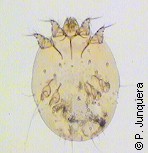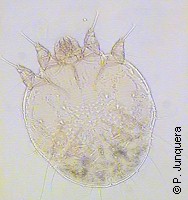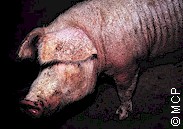The most important mange mite species on pigs is Sarcoptes scabiei var. suis. It causes sarcoptic mange (also called scabies) that affects pigs of any breed and age worldwide.
Another less frequent and rather benign pig mange mite species is Demodex phylloides, responsible for demodectic mange.
Infestations with mites are technically called acariosis or acariasis, both on animals and humans.
Biology and life cycle of pig mites

Sarcoptes scabiei var. suis
Sarcoptic mange mites are very small (0,45 mm long) and can be seen only under microscope. There are species-specific strains that attack cattle, sheep, goats and also humans. As a general rule, pig mange mites are not contagious for cattle, sheep, or humans, and vice-versa.
As all mite species, pig mange mites spend their whole life on the same host. The mites dig tunnels beneath the skin. Their saliva has potent digestive enzymes that dissolve the skin tissues. They feed on the resulting liquids. They do not suck blood.
Adult females deposit their eggs in tunnels, which hatch in 3 to 5 days. The whole development through several larval and nymphal stages can be completed in less than 2 weeks. Adults live for 2 to 3 weeks. Off the host the mites survive only a few days: the warmer the temperature, the shorter the survival: at >30° C they do not survive more than 1 hour.
Harm to pigs is never deadly, but not irrelevant. Mite digging causes skin irritation, which is enhanced by allergic reactions to the saliva that develop within 3 to 7 weeks after infestation. The affected skin shows redness, and becomes thicker and pimply, with appearance of scabs. The most affected parts are the ears, around the eyes, the neck and the back.
Pigs affected by itching often shake their heads and rub intensively against whatever objects around them, which causes hair loss and sometimes also bleeding injuries that can become infected with secondary bacteria.

Sarcoptic mange can be recognized by the symptoms described. Rubbing causes a typical noise in a pig house that indicates that there is a problem. If a closer inspection of rubbing animals does not show any lice, mites are likely to be the problem. Diagnosis has to be confirmed examining skin scrappings (preferably of the ears) under the microscope for visualization of the mites. Or using an ELISA test for sarcoptic mange, although this tests has only 80% sensitivity in growing pigs and less in sows.
The disease remains often latent: a few mites may be present, particularly in the ears, without causing clinical symptoms. For reasons not yet elucidated, the disease breaks suddenly out in a few animals that quickly transmit it to the others. Transmission is mainly by contact, sometimes by picking mites from the immediate environment. Piglets are especially susceptible to become infested by the sows. This means that there are no external vectors that transmit the mites, e.g. insects, worms, rats, mites, birds, etc., as it happens with many other parasites.
In regions with a cold winter (e.g. most of Europe, Canada, Northern USA, etc.), pig mange tends to be a winter pest. By cold weather the animals crowd together to benefit from body heat: the closer the contact, the faster is mite transmission.
Economic loss due to pig mange is difficult to estimate. Several studies suggest up to 10% reduction of feed conversion. Carcasses and hides of affected animals are often downgraded at slaughter.
Demodex phylloides
Pig demodectic mange mites are even smaller (~0.25 mm) than pig mange mites. They get into the hair follicles and sebaceous glands and build nodules that can become infected with secondary bacteria. The life cycle takes about 3 weeks, but is poorly understood.
Infestations often start around the nose and the eyelids to later spread throughout the whole body. Pig demodectic mange is usually rather benign, unless in cases of very heavy infestations.
Mange mites, whether sarcoptic or demodectic, do not transmit microbial diseases as many other livestock parasites do.
Click here to learn more about the general biology of mites.
Prevention and control of pig mange mites
Prevention
Sarcoptic mange is the most frequent disease caused by an external parasite on pigs worldwide. Pigs in poor health and hygienic conditions are more prone to develop the disease. Consequently, a first measure to prevent the appearance of pig mange is to keep the animals well fed and in good health.

If a pig herd is free of mites, contamination can only com from pigs brought in. Consequently, to avoid contamination keep all incoming pigs isolated during an examination period and treat them repeatedly against mites if there is any doubt. Two treatments with a macrocyclic lactone (e.g. doramectin, ivermectin) with 7 to 10 days interval should do the job, but keep the animals isolated until 10 days after the second injection. Remember that pigs may be infected with mites without showing clinical signs!
For the time being there are no vaccines that will protect pigs against mange mites by making them immune to them. There are no repellents, natural or synthetic that will keep mites away from pigs.
There are no biological control means for controlling pig mange mites (or any other mites of livestock and pets). Learn more about biological control of ticks and mites.
There no traps for mite catching, for the simple reason that they spend their whole life on the animals.
Control
To control established infestations it is crucial to treat all the animals in the herd, regardless of whether they show clinical symptoms or not. It is particularly important to thoroughly treat the boars and the sows. Boars are often the primary source of mites, which they easily transmit to the sows. Treating the sows is crucial to prevent transmission to the baby pigs, which are particularly susceptible to mites.
It is very important to repeat the treatment at least once about 10 days after the first treatment. The reason is that no parasiticide will kill the eggs. Ten days after the first treatment surviving eggs will have hatched and the larvae can be killed by the second treatment.
Eradication of mange mites has been achieved with two consecutive macrocyclic lactone treatments (e.g. doramectin, ivermectin) of all the animals in the herd, or with three topical treatments (mostly power spraying) with organophosphates (e.g. diazinon, phosmet, phoxim) or amitraz.
Injectables against pig mites contain always a macrocyclic lactones (e.g. doramectin, ivermectin). Ivermectin is also available as a feed additive. Macrocyclic lactones as injectables or feed additives are more effective and convenient than topical products, however also significantly more expensive.
Concentrates for spraying (in a few places also for dipping) contain mostly organophosphates (e.g. diazinon, phoxim), amitraz, and synthetic pyrethroids (e.g. cypermethrin). At least one liter solution has to be used per animal and care must be taken that the whole body of each animal is treated. Power spraying is clearly better than hand spraying in order to ensure that enough product reaches all body parts that can be infected, including the ears. If an animal has already thick scabs, it may be necessary to brush the scabby skin with the treating solution, otherwise the acaricide may not get inside and mites may survive the treatment.
There are also ready ready-to-use pour-ons with organophosphates (e.g. phosmet, phoxim) or amitraz.
| If available, follow more specific national or regional recommendations or regulations for mite control. |
Click here to learn more about the general features of parasiticides.
Resistance of pig mange mites to parasiticides
So far there are no reports on pig mange mites resistance to parasiticides.
This means that if a product fails to achieve the expected efficacy, it is extremely unlikely that it may be due to resistance of the mites to the product. Either the product was used incorrectly, or it was not appropriate for mange mite control.
Learn more about parasite resistance and how it develops.